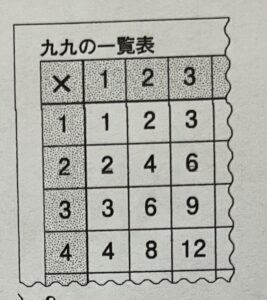青森県公立高校入試分析(英語)の2回目です。
今回は、第2問を扱いますが、
第2問では、「並べ替え、英問に対する規定語数以上の答え」を求める問題です。
それでは第2問を見て行きます。
第2問の配点は、
( 1 )は各2点✖️3=計6点
( 2 )が2点
(3)は各3点✖️2=計6点 なので、合計14点となっています。
第2問・・・対話文からの問題
次の英文は、中学2年生のショウタ(Shota)と、アメリカ人留学生のエマ (Emma) の対
話の一部です。ショウタは、エマに、九九の一覧表を見せながら話をしています。これを
読んで、あとの(1)~(3)に答えなさい。(14点)

Shota:How do you *memorize this in America? ア( me about tell you it can ),
please?
Emma:As an example, when we memorize 2×2=4, we say “two *times two is
four,” and when we memorize 2×3=6, we say “two times three is six.”
Is this different from you?
Shota:No, it isn’t. It sounds the same, but we have an interesting way to say
this in Japan. イ( what know is you it do )?
Emma:Not really. You usually count numbers, “ichi, ni, san, shi, go, roku…”
Shota:That’s right. We use them to say numbers like singing a song. When
we memorize, 2×2=4, we can say “ni-nin-ga-shi.” When we see 2×3
=6, we can say “ni-san-ga-roku.” They sound like songs, right?
Emma:Yes, that’s amazing.
Shota:It is said that this way helps Japanese people memorize this easily. Well,
have you ever heard that Japanese people also say numbers, “hi, fu, mi,
yo, itsu, mu…?” It can be used when we want to memorize several
numbers easily.
Emma:I’ve 【 】heard of it! It is new information to me.
Shota:This gives us a faster and easier way to memorize numbers. How do you
remember the √2? You know it is 1,41421356 … We remember it with
the *phrase “hitoyohitoyoni-hitomigoro.” It is very famous and popular
among Japanese students because it is fun just by saying it.
Emma:Oh, “hitoyohitoyoni-hitomigoro?” Interesting?
Shota:I like making phrases by using these two ways. For example, I saw a long
number, 8724164, on a magazine last week. The number wasn’t
important to me, but I made a phrase, “hanani-yoimushi.” In this example,
I could imagine a picture that shows a cute *bee on a flower. We can
sometimes create the picture of it with the phrase.
Emma:If I think about the number like that, I’m sure that I can’t forget it easily”
ウ This is a ( to lot example remember good a ) of numbers.
Thank you for telling me.
(注)
memorize 〜を暗記する times 〜倍 phrase (s) 言い回し、フレーズ
bee ミツバチ
(1)並べかえ問題
下線部ア 〜ウについて、文の意味が通るように、( )内の語句をすべて用いて、
正しい順序に並べかえて書きなさい。大文字にする必要のある文字は大文字にしなさい。
アの並べ替え
ア( me about tell you it can ), please?
【解説】
・クエスチョンマークがあり、please があることから
相手に「依頼する疑問文」であることがわかります。
▶︎助動詞 can があり、「依頼」の文であれば、Can you 〜, please? の文です。
※ Can you 〜?「〜してくれませんか」という依頼の文になります。
▶︎動詞は tell で about があることから、「tell+人+about 〜」の形を使って、
「人」に「〜について」を話す、教える、という意味になります。
【解答】
・ここから、
ア ( Can you tell me about it ), please? となります。
[私にそのことについてどうか教えてくれませんか。]
イの並べ替え
イ( what know is you it do )?
【解説】
・最後にクエスチョンマークがついているので、「疑問文」です。
・wh疑問詞の what があるので、気をつけましょう。
※ただし、この「疑問文」に対する Emma の答えが “Not really.” となっているので
Yes/No 疑問文であることがわかります。
▶︎ ここから、おそらく Do you know 〜?のYes/No 疑問文だと予想がつきまます。
▶︎ そうすると残る what / is / it は、what の「間接疑問文」のようです。
「間接疑問文」の語順は、wh+主語+動詞 となりますので、注意!
【解答】
ここから、
イ ( Do you know what it is ) ? となります。
[あなたはそれが何だかわかりますか] – おそらく「九九の一覧表」を見せての質問
ウの並べ替え
ウ This is a ( to lot example remember good a ) of numbers.
【解説】
・並び替えの単語を見ると
▶︎ lot / a があり、後ろに of numbers があるので、( a lot ) of numbers で
ひとかたまりとなりそうです。
▶︎最初の部分が、This is a となっているので、「単数形」の名詞 example が
来ますが、good もあるので、This is a ( good example ) となりそうです。
☞ここから、This is a ( good example 〜 a lot ) of numbers.
残るのは to / remember なので、不定詞の形容詞的用法を使えそうです。
【解答】
ここから、
ウ This is a ( good example to remember a lot ) of numbers.
となります。
[これはたくさんの数を覚えるのにいい例ですね。]
(2)【 】に入る語
【 】に入る最も適切な英語を、次の1〜4の中から一つ選び、その番号を書きな
さい。
1 once 2 before 3 ever 4 never
※ I’ve【 】heard of it!
【解説】
・対話の流れからすると
Shota:それは私たち幾らかの数を簡単に記憶する時に使われます。
Emma:私はそれについて聞いた【 】. それは私にとって新しい情報です。
▶︎ Emma が「新しい情報」だと言っていることから、
「今まで聞いたことがない」という意味になればいいことがわかります。
【解答】
・never
※ I’ve never heard of it.
[私は一度もそのことについて聞いたことがありせん。]
(3)英作文
次の文章は、ショウタと話をした日の夜に、エマがショウタに送ったメールの内容の
一部です。下線部1、2をそれぞれ一つの英文で書きなさい。
Hi, Shota. I was happy to talk with you today. 1 私は日本に来てからずっと日本語
を勉強しています。Japanese has hiragana, katakana, and kanji, but I’m not good
at reading kanji. 2 日本語は他の言語よりも難しいです。
【解説】
・前後の英文も参考にしながら、「1」と「2」の日本文を英語にする問題です。
○「1」の日本文「私は日本に来てからずっと日本語を勉強しています。」
▶︎「ずっと〜している」と英文を作りましょう。
・現在完了の「継続」用法を用いるといいようです。
→ have +過去分詞 (study の過去分詞) となるので、I have studied Japanese
・「〜から」は、since を用いて、since 主語+動詞 の形を用います。
→「私が日本に来てから」ですから、come の過去形を用いて
since I came to Japan となります。
※ since の後にはこのように過去の文がこれることも覚えておきましょう。
【解答】
ここから、正解は
I have studied Japanese since I came to Japan. となります。
○「2」の日本文「日本語は他の言語よりも難しいです。」
▶︎「〜よりも難しい」という比較の英文を作りましょう。
・主語は、「日本語」で Japanese.
比較対象は「他の言語」なので other languages となります。
※「他の」のは、other でその後ろには複数形がきます。
・「難しい」は、difficult で「長い単語」なので、
比較級は、more difficult となります。
【解答】
ここからは
Japanese is more difficult than other languages. となります。

今回はここまで。



コメント